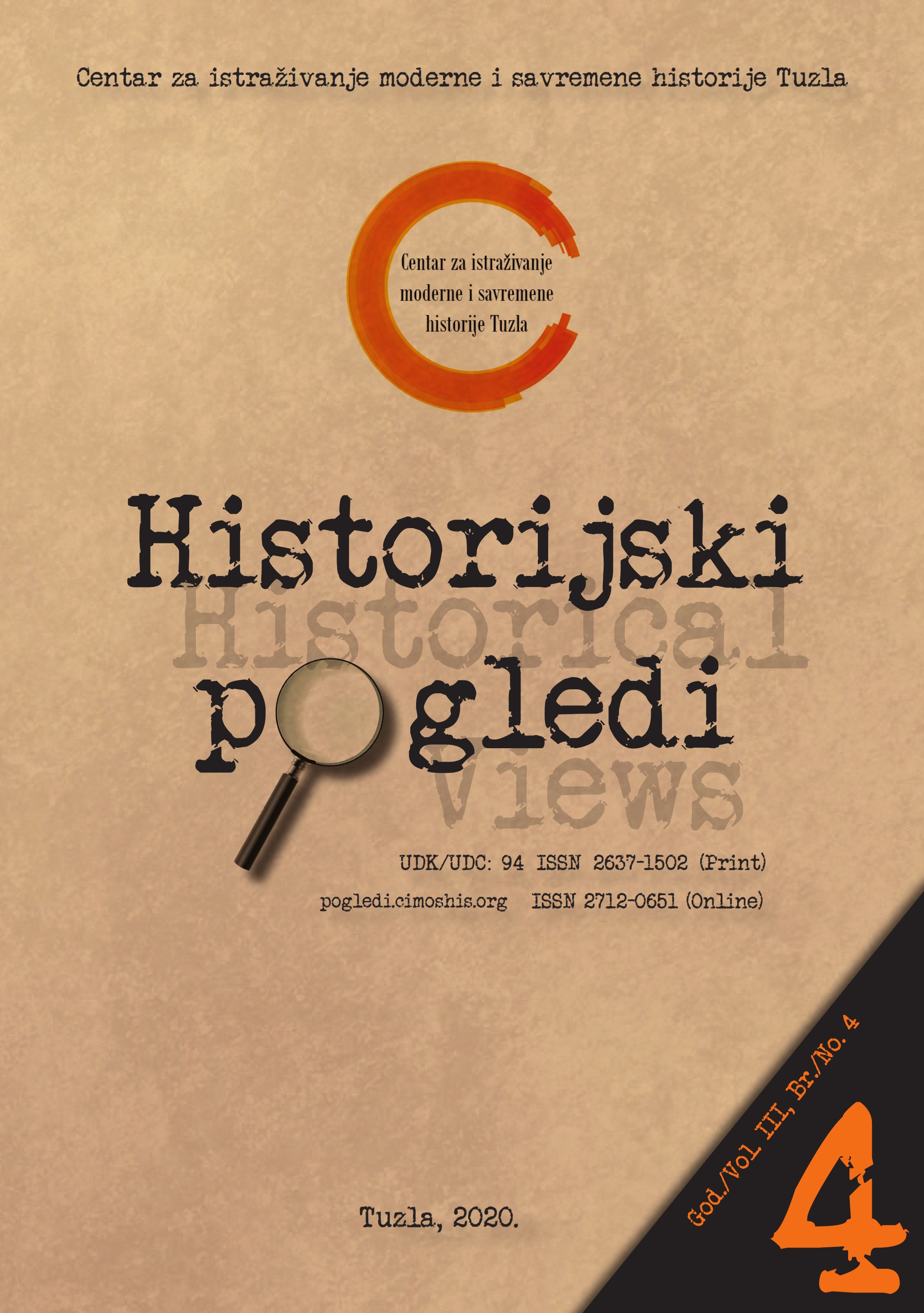BOSNA I HERCEGOVINA U KONCEPCIJAMA SRPSKOG KULTURNOG KLUBA
BOSNIA AND HERZEGOVINA IN SERBIAN CULTURAL CLUB CONCEPTS
Author(s): Osman SušićSubject(s): Cultural history, Diplomatic history, Political history, Interwar Period (1920 - 1939), WW II and following years (1940 - 1949)
Published by: Centar za istraživanje moderne i savremene historije Tuzla
Keywords: Bosnia and Herzegovina; Second world war; Exile government; The Chetnik movement; Serbian Cultural Club;
Summary/Abstract: This paper covers the period from 1937 to 1945, the period of the establishment and works of the Serbian Cultural Club. The paper will discuss the political circumstances in the Kingdom of Yugoslavia in wich Serbian Cultural Club was founded, as well as the program goals and its activities in Bosnia and Herzegovina. Special emphasis will be put on the period of the Second World War in the Bosnia and Herzegovina and the former common state and the activities of the Serbian Cultural Club in the Second World War. The work and achievement of the program goals of the Serbian Cultural Club in the Second World War will be presented through the work of the Exile Government in London and the activities of the Chetniks Movement in the Bosnia and Herzegovina and the former common state. The Serbian Cultural Club was formed as a form of political association and activity, which included politicians, public workers, scientists, members of various political organizations, representatives of state and parastate bodies and organizations, under the slogan "Serbs for Reunion". The club acted as a unique and homogeneous organization, regardless of the composition of the membership, with the goal of saving Serbia and Serbs. This most clearly expressed his overall activity, composition and degree of influence on state policy. The most important issues of state or Serbian nationalist policy for the interest of the Government were discussed in the Club, so the club had an extensive network of boards and several media. Professor and Rector of the University of Belgrade, Dr. Slobodan Jovanović, was elected the first president of the Serbian Cultural Club. He was the ideological creator of this organization (and he set out the basic tasks and goals of the Club). The vice presidents were Dr. Nikola Stojanović and Dr. Dragiša Vasić, and Dr. Vasa Čubrilović the secretary. Dr. Stevan Moljevic was the president of the board of the Serbian Cultural Club for the Bosnian Krajina, based in Banja Luka. According to Dinić, the initiative for the formation of the Serbian Cultural Club was given by Bosnian-Herzegovinian Serbs Dr. Nikola Stojanović, Dr. Vladimir Čorović, Dr. Vladimir Grčić and Dr. Slobodan Jovanović. The activities of the Serbian Cultural Club can be divided into two stages. The first from its founding in 1936 until the signing of the Cvetković-Maček agreement, and the second from 1939 to 1941. The program of the Serbian Cultural Club was a sum of Greater Serbia programs of all major political parties that operated in Serbia with the help of state institutions. The goals of the Serbian Cultural Club were mainly: expansionist policy of expanding Serbian rule to neighboring areas, denying the national identity of all other Yugoslav nations and exercising the right to self-determination. The program goals of the Serbian Cultural Club were to propagate Greater Serbian ideology. With its program about Greater Serbia and its activities, the Serbian Cultural Club has become the bearer of the most extreme Serbian nationalist aspirations. After the Cvetković-Maček agreement of August 1939, the Serbian Cultural Club demanded a revision of the agreement, calling for a Serbo-Croatian agreement based on ethnic, historical or economic-geographical principles. The adoption of one of these principles was to apply to the entire area inhabited by Serbs. The subcommittees of the Serbian Cultural Club in Bosnia and Herzegovina had the primary task of working to emphasize its Serbian character, and after the Cvetkovic-Macek agreement to form awareness that the whole of Bosnia and Herzegovina should enter the Serbian territorial unit. With the prominent slogan "Wherever there are Serbs - there is Serbia", the Serbs in Bosnia and Herzegovina were marked as the "vigilant guardian of the Serbian national consciousness". The leadership and most of the members of the Serbian Cultural Club joined the Chetnik movement as Draža Mihailović's national ideologues. The policy of the militant Greater Serbia program and Serbian nationalism of the Serbian Cultural Club was accepted as the program of Draža Mihailović's Chetnik movement. Some of Draža Mihailović's most important associates belonged to the Serbian Cultural Club. The main political goals of the Chetnik movement are formulated in several program documents. The starting point in them was the idea of a "Greater and Homogeneous Serbia", which was based on the idea that Serbs should be the leading nation in the Balkans.
Journal: HISTORIJSKI POGLEDI
- Issue Year: III/2020
- Issue No: 4
- Page Range: 108-132
- Page Count: 25
- Language: Bosnian

